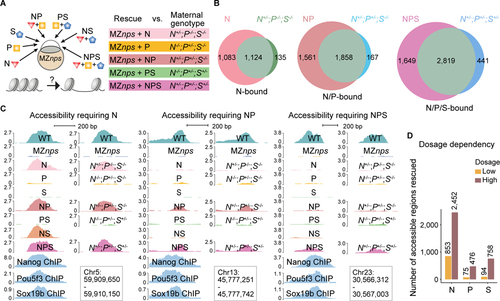Fig. 5
- ID
- ZDB-FIG-230318-14
- Publication
- Miao et al., 2022 - The landscape of pioneer factor activity reveals the mechanisms of chromatin reprogramming and genome activation
- Other Figures
- All Figure Page
- Back to All Figure Page
|
Nanog, Pou5f3, and Sox19b function independently and cooperatively to remodel chromatin.
(A) Schematic illustrating the approach to test the pioneering activity of N, P, and S ? alone and in combination - by either TF restoration (N, P, and S denote the injected mRNAs) in MZnps embryos, or different combinations of mutants deprived of maternal contribution of the corresponding TFs. (B) Venn diagrams showing significant overlap of Group 1 regions that are rescued in different TF conditions (top left of each diagram) and corresponding genotypes (top right of each diagram). For example, most regions where accessibility was rescued by N (restoring Nanog in Maternal-zygotic-nanog?/?;pou5f3?/?;sox19b?/?) remain accessible in the N+/?;P?/?;S?/? (Maternal-nanog+/?;pou5f3?/?;sox19b?/?) mutant embryos. (N (P < 10?100); NP (P < 10?100); NPS (P = 1.1 × 10?93) Fisher?s exact test). (C) Representative genome tracks showing accessibility in different rescue conditions and corresponding genotypes at regions that require one, two, and three NPS factors to rescue accessibility. (D) Bar plot comparing the number of regions in Group 1 that were bound and can be rescued by N, P, and S at low and high dosage. See also Figure S5. |

